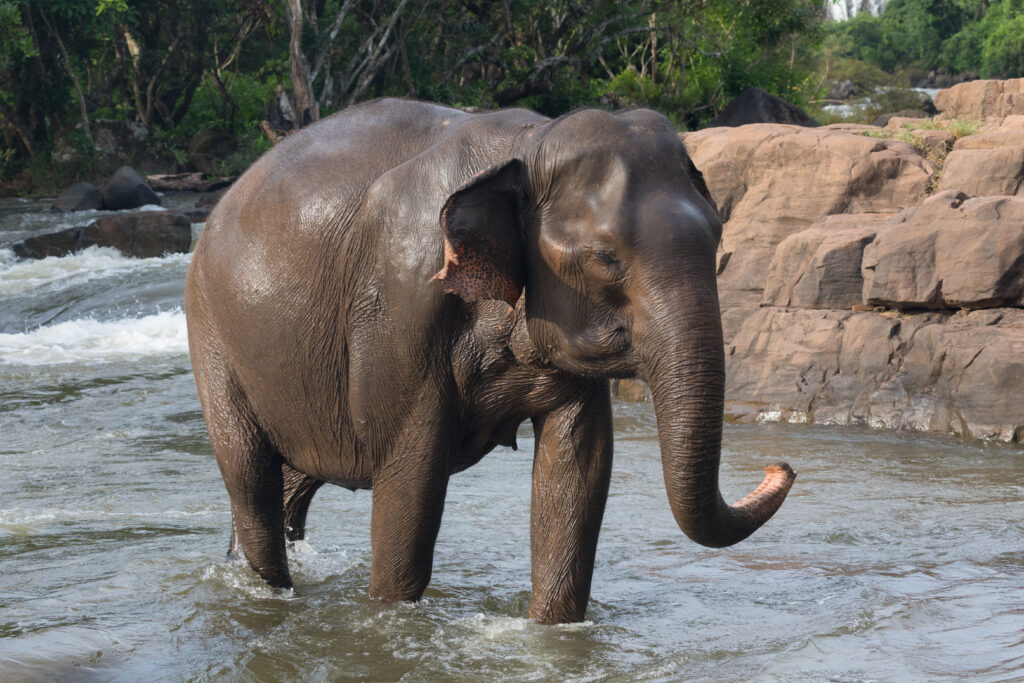British conservationist and playboy Mark Shand was born on June 28, 1951 (died in 2014). After an early life of adventure and high-living, Shand committed himself to the conservation of Asian elephants in India.
Mark Shand was born into a privileged family in England; his sister is Camilla Parker Bowles, Duchess of Cornwall and wife of Charles, HRH the Prince of Wales. After being expelled from school for smoking pot, he fell into the 1960s hedonistic culture—Andy Warhol’s Studio 54 was one of his favorite haunts. He has been described as a “real-life Indiana Jones, whose rugged good looks and charm proved irresistible….” That charm led to a series of romances with some of the world’s best-known celebrities, including Bianca Jagger and Caroline Kennedy.

His cavalier life-style changed on a 1988 trip to India, where he fell in love—with an elephant. He found Tara laboring for peanuts—literally—and “rescued the beautiful female elephant from a life of begging and misery.” They bonded immediately, and for the next several years Shand rode Tara on a 1000-mile journey across India—memorialized in his 1992 book, “Travels with My Elephant.” This book, along with three other travel-adventure volumes, won major literary awards and established Shand as a top-selling author.
Shand used his notoriety as a writer and a man-about-town to publicize the plight of Asian elephants for more than a quarter century. In 2002, he founded the non-profit organization Elephant Family, enlisting the aid of his famous relatives and friends to spread awareness and raise funds (Prince Charles and the Duchess of Cornwall are co-presidents of the charity). Shand’s often-stated principle was, “Save the elephants and then you save the forest—and then you save yourself.”
Asian elephant survival is, indeed, in jeopardy. IUCN lists the species as endangered, noting that its formerly widespread populations have probably been declining for centuries to today’s critically small numbers. No more than 50,000 still exist in the wild. The major threat to their existence is habitat loss, as the human population of the India sub-continent continues to grow and occupy more land. Today, the available habitat for Asian elephants is only 5% of their original range.
Shand lobbied hard that elephant populations living in isolated preserves were unsustainable. They required habitat corridors so individuals and families could function as larger connected groups. He led a successful effort to create a dedicated habitat corridor in the southern Indian state of Kerala. Several other corridors connecting elephant populations have since been completed, with many more planned.
The Duchess of Cornwall remarked on the occasion of her brother’s death in 2014: “They say that elephants never forget; Tara never forgot him and neither will we.”
References:
Elephant Family. Protecting Asian elephants and their habitat. Available at: http://elephant-family.org/. Accessed June 29, 2017.
IUCN. 2017. Elephas maximus. IUCN Red List. Available at: http://www.iucnredlist.org/details/7140/0. Accessed June 29, 2017.
Keleny, Anne. 2014. Mark Shand: Campaigner whose efforts to save the Asian elephant took him far beyond the privileged circles from which he came. The Independent, April 24, 2014. Available at: http://www.independent.co.uk/news/obituaries/mark-shand-campaigner-whose-efforts-to-save-the-asian-elephant-took-him-far-beyond-the-privileged-9284764.html. Accessed June 29, 2017.
Lee, Adrian. 2014. The crazy life of Camilla’s playboy brother Mark Shand. The Express, April 25, 2014. Available at: http://www.express.co.uk/news/royal/472310/The-crazy-life-of-Camilla-s-playboy-brother-Mark-Shand. Accessed June 29, 2017.
Sanctuary Asia. 2011. Right of Passage: Elephant Corridors of India. Sanctuary Asia, April 2001. Available at: http://www.sanctuaryasia.com/magazines/cover-story/6830-right-of-passage-elephant-corridors-of-india.html. Accessed June 29, 2017.
The Prince of Wales and The Duchess of Cornwall. 2014. Times article by The Duchess of Cornwall on her brother, Mark Shand. September 14, 2014. Available at: https://www.princeofwales.gov.uk/media/press-releases/times-article-the-duchess-of-cornwall-her-brother-mark-shand. Accessed June 29, 2017.
